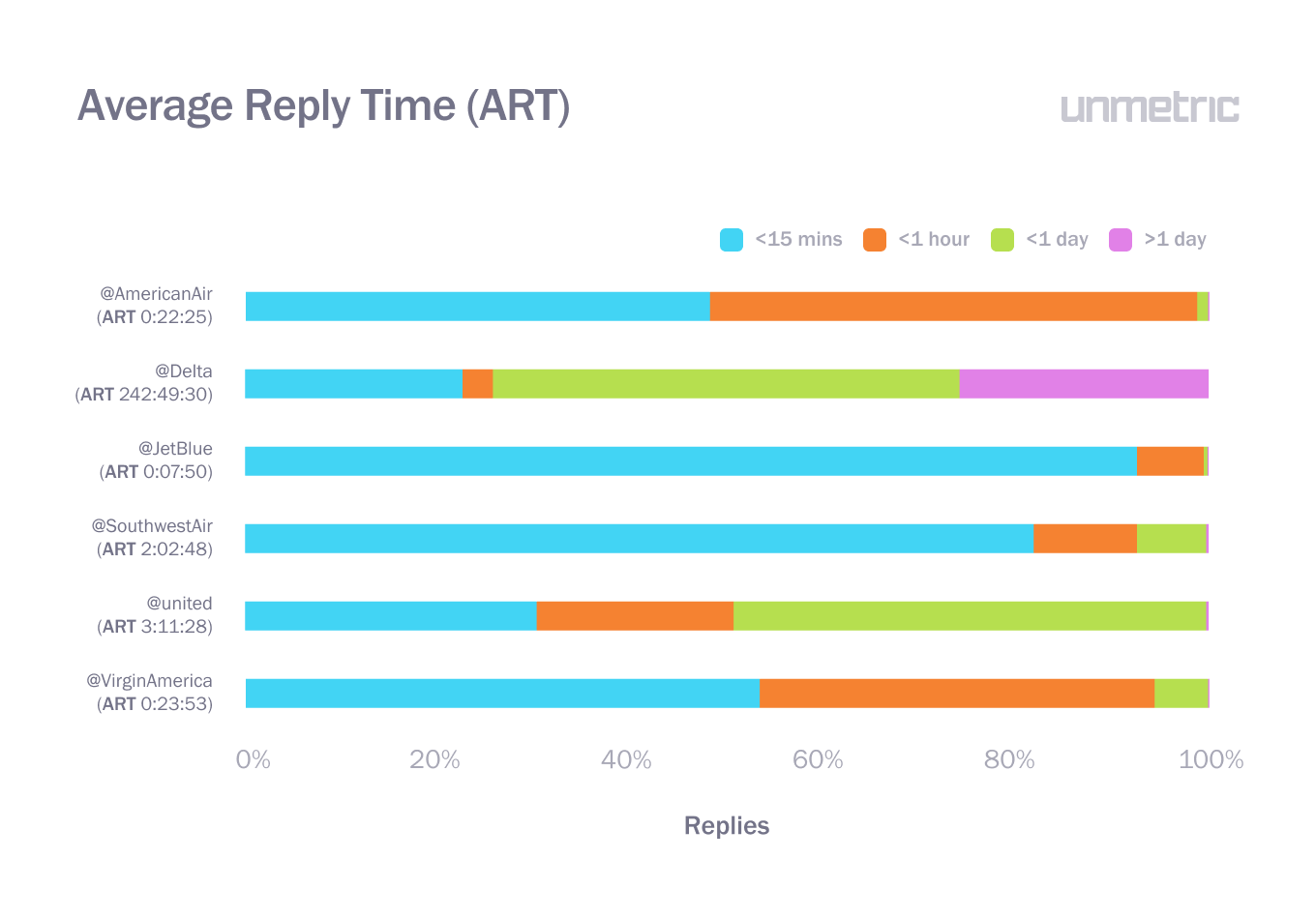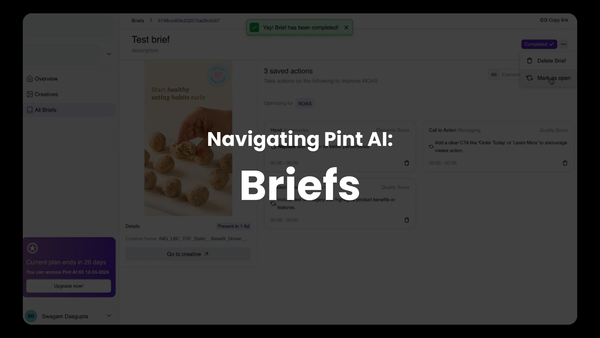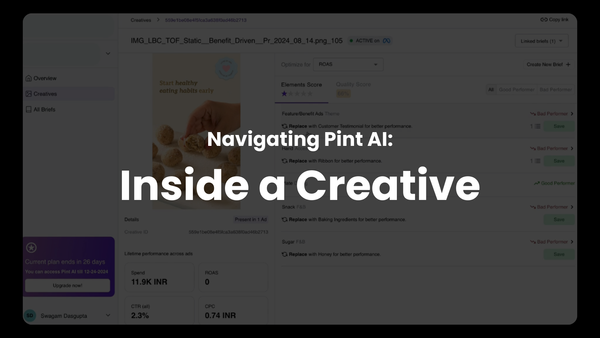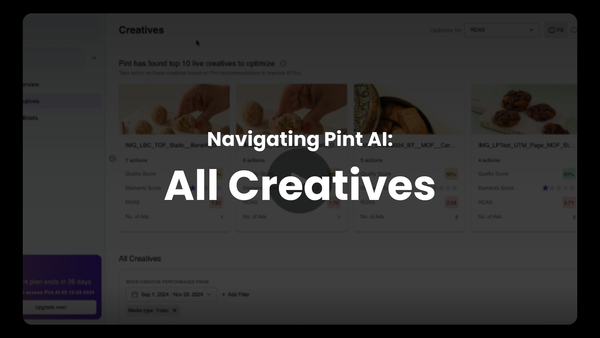Creative Analytics 109: Performance Benchmarking for Higher Creative ROAS
Performance benchmarking is crucial. It can boost the returns you get on your creative. Here's how.

The synergy between creative analytics and performance benchmarking has to be a crucial element for media buyers aiming to optimize their campaigns.
Performance benchmarking, the process of comparing your performance metrics against industry standards or competitors, offers valuable insights that can be leveraged to refine creative strategies.
But how can you do this effectively?

Understanding Performance Benchmarking
Performance benchmarking involves measuring key performance indicators (KPIs) such as click-through rates (CTR), conversion rates, engagement rates, and return on ad spend (ROAS) against industry norms or top-performing competitors.
This comparative analysis helps identify strengths, weaknesses, and opportunities for improvement within your campaigns.
Identifying Key Performance Indicators (KPIs)
Step one in performance benchmarking for creative analytics is to identify the most relevant KPIs. These might include:
- Click-Through Rate (CTR): Measures the number of clicks your ad receives divided by the number of times it is shown.
- Conversion Rate: The percentage of users who take a desired action after clicking on your ad.
- Engagement Rate: Tracks interactions such as likes, shares, and comments.
- Return on Ad Spend (ROAS): Evaluates the revenue generated for every dollar spent on advertising.
Analyzing Competitor Performance
Once this is done, you can begin to gather data on your competitors’ creative performance. What this means is that you should be able to see which creatives are really working for your competitors or your industry as a whole.

Look at metrics such as engagement rates, CTR, and conversion rates to pick out these creatives. With tools like what we're building at Pint AI, you can also go deeper than just creatives:
- People: If your industry is using influencers' faces in their ads, which influencer is giving great results?
- Objects: What is the most common + most effective placement in your ad for your products?
- CTAs: Which CTAs are working for what kinds of ads at different stages of the funnel, across your industry?
- Messaging: Is a certain kind of tone (like empathetic or confident) of your ad copy driving more results for your competitors?
Unlocking all this information at an industry level, and eventually see how you're performing against specific competitors — this will help you set relevant performance benchmarks.
Setting Benchmarks and Goals
The next step is that, based on the data collected from competitor analysis, you have to establish performance benchmarks for your campaigns.
For example, if the industry average CTR is 2%, your goal might be to meet or exceed this benchmark.
Setting specific, measurable targets for your creative assets ensures that your campaigns are aligned with industry standards and poised for success.
Incorporating Benchmarked Insights into Creative Development
Now comes the question of actually using these insights in your creative process. Here are the two most common ways in which you can do this:
- Creative Briefs: Use benchmark data to inform creative briefs. Highlight key performance elements such as preferred ad formats, effective color schemes, and optimal messaging strategies identified from benchmarking data.
- Iterative Testing: Implement A/B testing to compare different creative variations against the benchmarks. Continuously refine and optimize based on test results to improve performance metrics.
Real-Time Monitoring and Adjustments
Performance benchmarking is useless until you actually monitor and make adjustments.
Utilize real-time analytics to monitor how your creatives are performing against the established benchmarks. This allows for quick adjustments to optimize performance.
Set up alerts for significant deviations from benchmarks to take immediate corrective actions and maintain campaign effectiveness.
Periodic Review and Optimization
Regularly reviewing campaign performance against benchmarks is crucial for ongoing optimization:
- Performance Reviews: Schedule regular reviews to compare your creative performance with the benchmarks. Analyze which elements consistently perform well and which need further optimization.
- Strategy Refinement: Use insights from these reviews to refine your overall creative strategy. This could involve shifting budget towards higher-performing creative types or adjusting targeting strategies to better align with top-performing benchmarks.
Combining Creative Analytics with Benchmarking Tools
Integrating creative analytics with benchmarking tools can streamline the process of tracking and optimizing creative performance:
- Unified Dashboards: Use platforms that integrate creative analytics and benchmarking data into unified dashboards. This allows for seamless tracking of how creative performance compares against benchmarks and facilitates quick adjustments.
- Performance Alerts: Set up alerts for when performance metrics deviate significantly from benchmarks. This helps in taking immediate action to correct any issues and improve campaign effectiveness.
Tailoring Creative for Target Segments
Benchmarking can reveal which creative elements work best for different audience segments. Use this data to tailor creatives specifically for high-value segments identified through performance benchmarking.
This targeted approach ensures that your ads resonate with the right audiences, driving higher engagement and conversions.
Enhancing Collaboration Between Creative and Media Teams
Effective integration of performance benchmarking and creative analytics requires seamless collaboration between creative and media teams:
Data-Driven Creative Briefs:
Include benchmark insights in creative briefs to guide the development process. Highlight key performance elements such as preferred ad formats, effective color schemes, and optimal messaging strategies identified from benchmarking data.
Performance Reviews:
Schedule regular performance reviews where both creative and media teams assess campaign results against benchmarks. This collaborative approach ensures that both teams are aligned on what’s working and what needs adjustment.
By systematically integrating performance benchmarking into your creative analytics process, you can ensure that your creative assets are not only meeting industry standards but are also continuously optimized to achieve better results.
Conclusion
Performance benchmarking provides a structured approach for media buyers to enhance their creative analytics. By identifying key performance indicators, analyzing competitor performance, setting benchmarks, incorporating insights into creative development, and continuously monitoring and optimizing campaigns, media buyers can significantly improve their campaign outcomes.
The integration of benchmarking data with creative analytics ensures that creative decisions are data-driven, targeted, and aligned with industry standards, leading to more effective and impactful advertising efforts.





